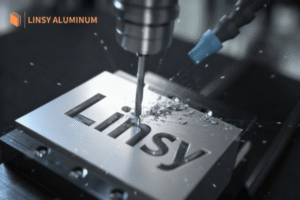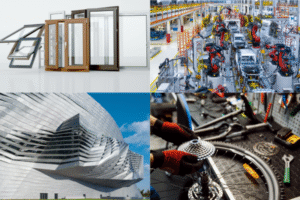Key Highlights
- A versatile, heat-treatable aluminum alloy in the 6000 series known for its strength, weldability, and corrosion resistance
- Possesses a blend of moderate strength and formability
- Extensively used in structural applications, such as bridges, railings, and frames
- Suitable for various industries, including construction, transportation, and manufacturing
- Outperforms other aluminum alloys in applications requiring a balance of strength, corrosion resistance, and workability

Introduction
Aluminum alloys are renowned for their lightweight nature, corrosion resistance, and impressive mechanical properties. 6005 Aluminum is a popular choice among these alloys in various industries, including construction and manufacturing. Its unique blend of strength, weldability, and corrosion resistance makes it an excellent material for demanding applications.
Understanding 6005 Aluminum Alloy
6005 aluminum alloy is a member of the 6000 series aluminum alloys known for their excellent corrosion resistance, formability, and weldability. This particular alloy shines in applications with high corrosion resistance and moderate strength.
Furthermore, 6005 aluminum alloy is heat-treatable, meaning its mechanical properties can be enhanced through controlled heating and cooling processes. This characteristic broadens its applicability, allowing it to meet the specific needs of diverse projects. Its versatility and reliability have solidified its position as a sought-after material in numerous industrial sectors.
What is 6005 Aluminum Alloy?
6005 aluminum alloy is a notable material in the 6000 series. It stands out due to its unique chemical composition and mechanical properties. Crafted by combining aluminum with magnesium and silicon, these elements enhance the alloy’s performance. Its heat-treatable nature is key, with temper designations (e.g., T5, T6) indicating specific treatments. Each temper affects distinct mechanical properties, helping engineers choose the right option for applications. Industry standards from ASTM International outline specifications for 6005 aluminum, ensuring quality and consistency across manufacturers.
Chemical Composition
The 6005 aluminum alloy’s unique characteristics arise from its precise chemical composition. It consists of 97.5% to 99.0% aluminum, which ensures a lightweight yet durable structure. Silicon (0.6% to 0.9%) enhances castability and strength, while magnesium (0.4% to 0.6%) further boosts strength and corrosion resistance. Additionally, trace amounts of iron, copper, manganese, chromium, zinc, and titanium improve performance, refine grain structure, enhance machinability, and increase resistance to stress corrosion cracking.
|
Element |
6005 Aluminum Alloy (%) |
|---|---|
|
Aluminum (Al) |
97.5 – 99.0 |
|
Magnesium (Mg) |
0.4 – 0.6 |
|
Silicon (Si) |
0.6 – 0.9 |
|
Iron (Fe) |
Max. 0.35 |
|
Copper (Cu) |
Max. 0.1 |
|
Manganese (Mn) |
0.4 – 0.9 |
|
Chromium (Cr) |
Max. 0.1 |
|
Zinc (Zn) |
Max. 0.1 |
|
Titanium (Ti) |
Max. 0.1 |
|
Others |
Remaining |
Key Physical Properties
6005 aluminum exhibits outstanding physical properties crucial for various structural applications. Known for its high tensile and yield strength, this aluminum alloy offers excellent corrosion resistance, making it a preferred choice in different industries. Its lightweight nature, good corrosion resistance, and machinability add to its appeal. The chemical composition of 6005 aluminum, featuring silicon, magnesium, and manganese, contributes to its superior performance. When considering the right alloy for structural applications, 6005 aluminum stands out for its strength, durability, and workability.
|
Property |
6005-T5 |
6005-T6 |
Unit |
|---|---|---|---|
|
Tensile Strength |
≥ 190 |
≥ 260 |
MPa |
|
Yield Strength |
≥ 110 |
≥ 240 |
MPa |
|
Elongation at Break |
~10–12 |
~8–10 |
% |
The Common Tempers of 6005 Aluminum-T5, T6
6005 aluminum alloy is available in two tempers: T5 and T6, indicating their mechanical properties from heat treatments.
The T5 temper denotes artificial aging after extrusion, enhancing tensile strength and hardness over non-heat-treated forms. It’s suited for moderate strength applications, like architectural extrusions and structural components. The T6 temper, involving solution heat treatment and artificial aging, provides the highest strength and is ideal for high-demand applications, such as structural members and bridges. Choosing between T5 and T6 tempers depends on the specific mechanical and environmental needs of the application.
Typical Applications of 6005 Aluminum Alloy
6005 aluminum alloy, due to its outstanding combination of strength, corrosion resistance, and workability, finds its use in a variety of applications:
- Construction: It is an excellent material for window frames, doors, roofing, railings, and other structural components where lightweight yet durable solutions are preferred.
- Transportation: This alloy is valued in the automotive industry for manufacturing vehicle parts, such as body panels, frames, and wheels.
- Industrial: It serves as a crucial element in constructing ladders, scaffolding, signs, and various other industrial equipment.
Industrial Uses of 6005 Aluminum
6005 aluminum alloy’s impressive properties make it highly sought-after in various industrial applications. Its versatility becomes evident in its adaptability to different manufacturing processes, including extrusion. Aluminum extrusion is a process of shaping a heated aluminum billet through a die to create a continuous profile with a specific cross-section.
The excellent extrusion characteristics of 6005 aluminum alloy allow manufacturers to produce various aluminum products with intricate designs and tight tolerances. These products are used in industries that require lightweight yet strong components.
Some typical industrial applications of extruded 6005 aluminum profiles include:
- Construction: Curtain walls, window frames, door frames, handrails, and structural support systems.
- Transportation: Body panels, roof rails, structural components for trucks, trailers, and railcars
- Electrical: Enclosures for electrical components, heat sinks, and busbars.
Advantages in Construction and Transportation
6005 aluminum alloy enjoys extensive use in construction and transportation due to its unique advantages:
- High Strength-to-Weight Ratio: This favorable ratio makes it ideal for constructing lightweight yet robust structures, reducing material consumption, lower transportation costs, and easier installation.
- Corrosion Resistance: 6005 aluminum’s natural corrosion resistance ensures longevity in harsh environments, reducing maintenance needs and extending the lifespan of structures.
- Design Flexibility: The alloy’s excellent formability and extrusion properties enable architects and engineers to create complex shapes and intricate designs, enhancing the aesthetic appeal of buildings and vehicles.
This alloy contributes to developing sustainable and efficient solutions in the construction and transportation sectors, furthering innovation and advancement.
Comparing Alloys: 6005 vs. 6061 vs. 6063 vs 6060
While 6005 is an excellent choice for many applications, it’s crucial to understand its position among other commonly used alloys in the 6000 series, such as 6061, 6063, and 6060. Each variation has unique strengths:
- 6061 aluminum: Holds the title of the most versatile, valued for its strength, machinability, and corrosion resistance, ideally suited for structural applications requiring high strength, such as aircraft and bike frames.
- 6063 aluminum: Known for its superior surface finish and ease of extrusion, taking the spotlight in architectural applications for components such as window frames, door frames, and railings.
- 6060 aluminum is favored for its good corrosion resistance and affordability. It finds its niche in applications like general-purpose tubing, trim, and decorative elements.
The optimal choice hinges on the application’s specific requirements. Understanding the subtleties of each alloy empowers informed decisions.
Benefits and Limitations of 6005 Aluminum Alloy
6005 aluminum alloy boasts a remarkable combination of benefits, solidifying its position as a top material across industries:
- Exceptional Weldability: It readily lends itself to welding processes, simplifying joining and assembly operations.
- Remarkable Durability: This alloy delivers outstanding durability, effectively resisting wear and tear, making it suitable for demanding applications.
- Impressive Cost-Effectiveness: 6005 aluminum alloy provides an economical solution over its lifespan when considering its strength-to-weight ratio and longevity.
However, some limitations must be acknowledged:
- Strength Considerations: Compared to alloys like 6061, 6005 exhibits slightly lower strength, potentially limiting its application where high strength takes precedence.
Conclusion
In conclusion, understanding the properties and applications of 6005 Aluminum Alloy is crucial for industries like construction and transportation. Its advantages, including high strength and corrosion resistance, make it a preferred choice. However, limitations in marine environments should be noted. Compared to other alloys like 6061 and 6063, 6005 stands out for its specific uses.
Why Choose Linsy Aluminum
As one of the leading aluminum brands and a top supplier in China, Linsy Aluminum emphasizes quality and reliability in all its products. Our advanced aluminum factory in China manufactures high-performance aluminum alloys that satisfy the toughest industry requirements. Dedicated to excellence, we provide precision, durability, and tailored options to accommodate your specific project needs, establishing us as a trusted partner for businesses globally searching for exceptional aluminum solutions. GET A QUOTE
Frequently Asked Questions
What sets 6005 aluminum apart from other alloys?
6005 aluminum alloy distinguishes itself through its higher strength compared to other commonly used aluminum alloys, such as 6063. It boasts exceptional corrosion resistance, making it suitable for outdoor applications, and exhibits good weldability.
Can 6005 aluminum be used in automotive applications?
Yes, 6005 aluminum alloy is used in automotive components. Its lightweight nature contributes to fuel efficiency, while its high strength and durability ensure its structural integrity and long-term performance.
How does the strength of 6005 compare to 6061 aluminum?
While both alloys offer substantial strength, 6061 aluminum generally exhibits slightly higher tensile and yield strength than 6005. However, the mechanical properties of both alloys can vary depending on their tempers and processing techniques.
Are there any limitations to using 6005 aluminum in marine environments?
While 6005 aluminum alloy possesses good corrosion resistance, prolonged exposure to saltwater environments might necessitate protective coatings. These safeguard the alloy from potential corrosion and ensure its long-term performance in marine applications.
What is the difference between aluminum 6060 and 6005?
Both are aluminum alloys, but 6005 exhibits higher strength compared to 6060. The chemical composition differs slightly, affecting their mechanical properties and applications. 6060 is more common in general-purpose extrusions, while 6005 targets applications requiring higher strength.
What is the difference between 6005 and 6063?
The primary distinction lies in their silicon content and resulting mechanical properties. 6063, with a higher silicon content, exhibits excellent extrudability and a better surface finish, ideally suited for architectural applications, while 6005 prioritizes strength.
What is the difference between 6061 and 6005 aluminum?
6061 aluminum alloy surpasses 6005 in terms of overall strength levels. While both are widely used, their chemical compositions lead to differences in preferred applications and machining characteristics, influencing material choices for specific applications.
















